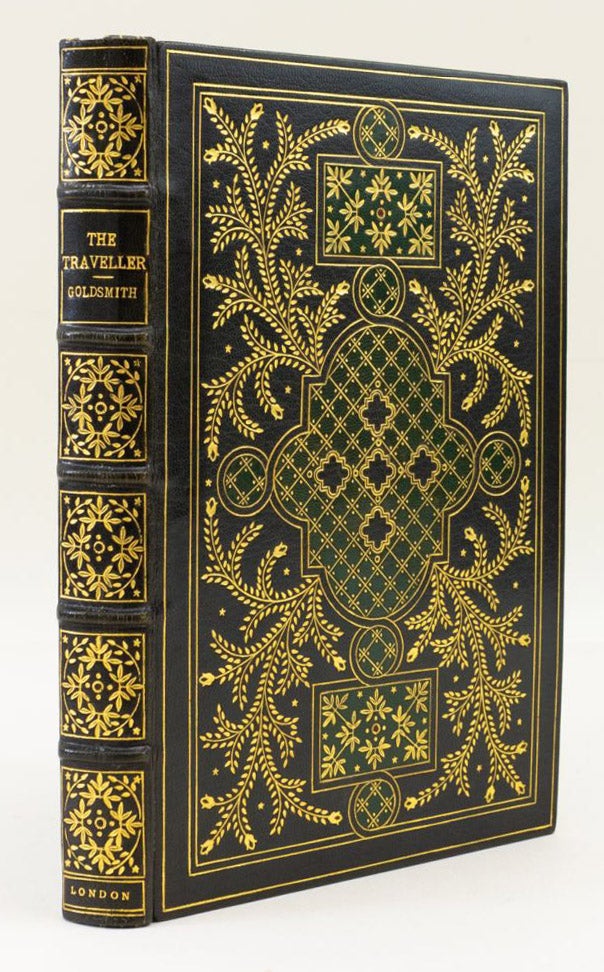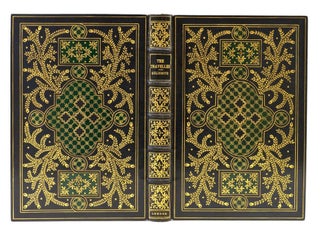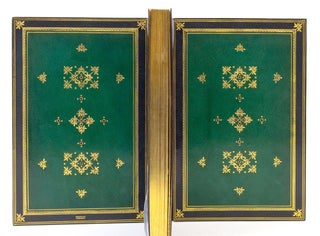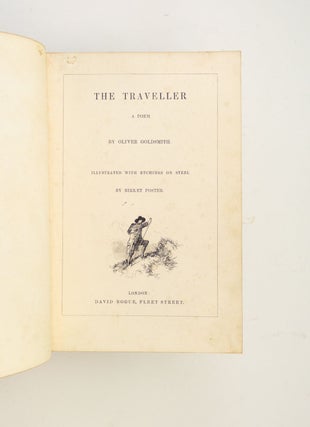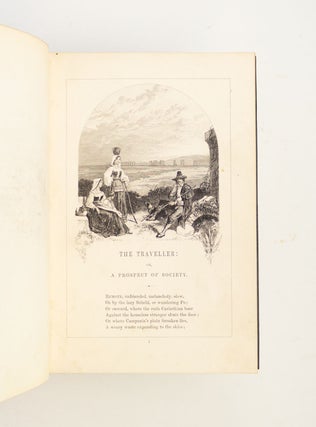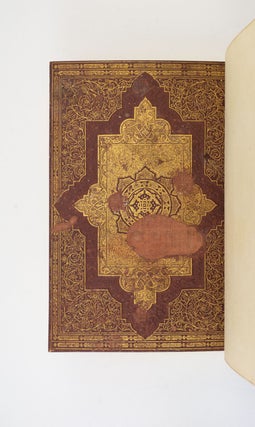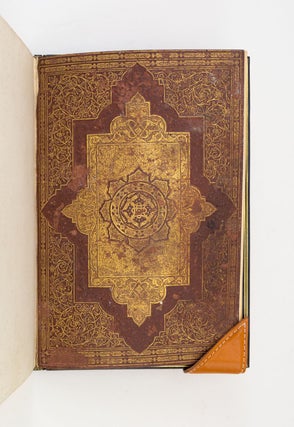THE TRAVELLER. A POEM.
(London: David Bogue, [1856]). 217 x 150 mm. (8 1/2 x 5 3/4"). 2 p.l., 39, [1] pp. First Edition with these Illustrations.
STRIKING DARK GREEN MOROCCO, VERY INTRICATELY GILT AND ONLAID, BY DONNELLEY OF CHICAGO (stamp-signed in gilt on front turn-in), covers with a fanfare-inspired design composed of a lobed centerpiece of onlaid emerald green morocco, diapered and dotted in gilt, containing five smaller cut-out lobed shapes outlined in gilt, the dark green of the boards showing through, left and right lobes of the centerpiece connected to a small emerald green circular onlay diapered and dotted in gilt, top and bottom lobes connected to a similar onlaid circle, followed by a green square onlay decorated with gilt leaves and a small central inlaid red dot, then another onlaid circle connecting to the double-rule border, exuberant sprays of small gilt leaves emanating from the centerpiece and filling the corners, raised bands, spine compartments with large fleuron composed of leaf tools emanating from a central gilt circle, EMERALD GREEN MOROCCO DOUBLURES within a dark green frame with plain and decorative gilt rules, gilt leaves at corner, central panel decorated with gilt leaves and inlaid red dots forming geometric shapes, navy blue watered silk endleaves, all edges gilt. With the original cloth covers and spine bound in at end. With 30 steel-etched illustrations by Birket Foster. Printed on thick card stock, most illustrations with a thick paper guard (or two) preceding it. ◆A very shallow (hardly noticeable) chip to head of spine, mild scattered foxing and occasional small stains to leaves, one leaf with a crease down the center, light offsetting from illustrations in two instances (the rest protected by guards); with some very minor defects, but an extremely attractive copy, the very elaborately decorated luxury binding in nearly fine condition.
This illustrated version of Goldsmith's chief poetic work was bound by one of the leading hand binderies in America, probably during the period when it was headed by the great Alfred de Sauty. Based in Chicago, the RR Donnelley printing company was a pioneer in promoting fine craftsmanship in American book production, particularly from the time Thomas E. Donnelley (1867-1955) became company president in 1899 on the death of his father, founder Richard Robert Donnelley. A talented salesman and visionary leader, Thomas instituted a printing apprenticeship program based on one run by French printer Imprimerie Chaix, and in 1921 he established a hand bindery, recruiting Alfred de Sauty (1870-1949) from the Central School of Arts and Crafts in London to run it. Though hand binding was not a money-making endeavor for the firm, the "Extra Bindery," as it was known, set an example for the rest of the company as well as for the industry in general of the importance of fine craftsmanship done in a traditional manner. According to the "Printing for the Modern Age" exhibit produced by the RR Donnelley Archive at the University of Chicago Library, "De Sauty immediately set the standard for American bookbinding when he hired three European-trained bookbinders, William Anson, Basil Cronk, and Leonard Mounteney. As was the European tradition, hand-binding at RR Donnelley was a team effort. The head of the bindery generally established the design and specified the materials. From there, a book passed through the hands of several staff members, each responsible for a particular aspect of the process; sewing, backing, tooling, and finishing." The tasteful design, fine materials, and quality workmanship of our binding are typical of the work done under de Sauty's supervision. He trained a number of fine binders, including his successor, Harold Tribolet, before his retirement in 1935.
First published in 1764, "The Traveller" examines the varying ways in which European cultures seek happiness and the excesses resulting from each approach, all in heroic couplets. Goldsmith's champion Samuel Johnson said that this was the best poem written since Pope, but this compliment may be tainted by self-interest, since, according to Boswell, Johnson wrote at least a small part of the poem, including eight of the concluding 10 lines. Illustrator Myles Birket Foster (1825-99) was an excellent choice for this work, as he was an enthusiastic traveller noted for his landscapes. The scenes here range from imposing cliffs to cozy taverns, and in keeping with the text display charming examples of happiness (a lakeside party with dancing) and touching moments of sorrow (a despairing artist weeping in his garret). The deluxe binding here may also be counted a source of joy and pleasure. (ST17020a)
Price: $4,000.00

